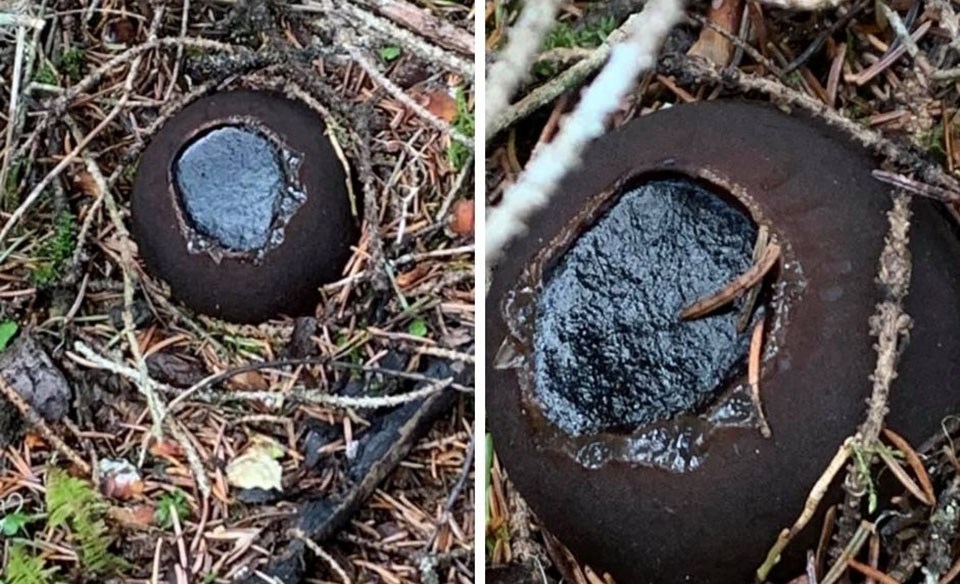A rare and unique-looking fungus called sarcosoma globosum — or more commonly known as witches cauldron — has recently been spotted around Prince George.
This fungus, which is normally found in northern Europe, is so rare and unique that it's missing off the official fungi list in British Columbia.
However, photos of the fungus found near Huble Homestead about 40 km north of Prince George have recently been shared on the Facebook group Questions and Answers P.G.
“Citizen scientists and naturalists do a fantastic job,” says Michael Preston, an assistant professor with the ecosystem science and management program at the University of Northern British Columbia (UNBC).
“Us scientists and universities are few in number and we can’t be out there seeing everything.”
As this fungus is so rare, Preston wants the public’s help to find and document witches cauldron in and around Prince George.
“One of the really neat things about witches cauldron is we know very little about it,” says Preston. “We don’t even know if we can grow it in the lab, for example, so very little is known.”
It’s called witches cauldron because that’s what it most resembles — it is a large round fungus, found in the springtime, with a central cup filled with a gel-like substance.
Preston says there are many theories as to why witches cauldron looks the way it does but it is not actually known what the gel is or why the fungus does this.
“Essentially, we think it’s filled with this gel to give it this big size which allows it to release spores,” he explains.
“That is one of the reasons it probably prefers the spring because it occurs after the spring melt and there’s lots of water around so it can take that water and put it into its fruiting body very easily.”
Preston says the fungus likely exists within the forest floor for decades, but only puts up a fruiting body (its witches cauldron-like shape) occasionally, which means a knowledgeable person has to come by at the right time to document it.
One of the big concerns about this species and another reason why it is so rare is clear-cut logging.
“What we know is that there’s no documented evidence that after clear-cut this fungus survives and there is no reported evidence that once the forest regrows again, into that new managed secondary growth forest, that the fungus comes back.”
It’s usually found in nutrient-rich spruce forests that are at least 100 years old, but because of human activity, it has become nationally extinct in some European countries, including Germany and Lithuania.
Preston says its ecological role within the forests is not even well understood.
“What is it doing here in British Columbia? Our environment is a bit similar to northern Europe so sure it should belong here, but what is it actually doing in the forest? We don’t know.”
It’s not yet understood if witches cauldron is a saprotrophic or a mycorrhizal fungus.
That means scientists don’t know if witches cauldron functions to decompose dead organic matter (saprotrophic) or if it has a symbiotic relationship with trees (mycorrhizal) to supply them with hard-to-get-nutrients in exchange for a food source.
Preston says mycorrhizal fungi are a part of the “wood-wide-web,” which is the concept that trees can communicate with each other through this symbiotic relationship with fungi.
“Is witches cauldron part of that? I don’t know and that is the cool thing,” says Preston. “If I can find where it is and then if we get some common known patches of where this occurs every year I can start to do studies and try and find out what is it doing. Is it decomposing dead organic matter or is it helping trees acquire nutrients? Two very different ecological roles.”
To try and answer some of these unknowns, Preston is embarking on a formal study of witches cauldron but needs the public’s help in locating it.
“We can try and get some actual documentation and publication that it is here in British Columbia despite all your maps saying it’s not and that is a fantastic finding.”
Preston has created a quick survey for the public to fill out if they spot witches cauldron when they are out exploring.
All you have to do is take a photo — or selfie — of the witches cauldron and note the GPS location (which you can do through an app) and submit that info through this online survey which goes directly to Preston at UNBC.
“There is a lot to learn about this fungus, its history, and what it’s doing,” says Preston. “Citizen scientists are my eyes and ears and I can’t be everywhere and I can’t see everything and they feed it back to me so I can direct my research efforts.”
The fruiting body of the fungus can be found for about 60 days in the springtime so the public may be able to spot it until the end of June at the latest.




